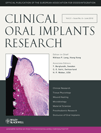Long-term response of osteogenic cells on micron and submicron-scale-structured hydrophilic titanium surfaces: sequence of cell proliferation and cell differentiation
Abstract
Objective: Modifications of surface topography and surface chemistry are key factors for guiding target cells during dental implant healing. Recent in vitro studies confirmed promotion of early osteogenic cell differentiation on submicron scaled surfaces in particular when hydrophilized. However, no long-term observations on both osteogenic cell proliferation as well as on cell maturation have been reported for respectively modified surfaces. Aim of this study was to monitor osteogenic cell proliferation and expression of specific osteogenic cell differentiation markers on a protein level over an extended period of 3 weeks with respect to surface modifications.
Material and methods: Modified titanium (Ti) disks were obtained from Institute Straumann, representing the following surfaces: smooth pretreatment (PT), sandblasted/acid etched (SLA), and hydrophilized (modSLA). Surface topography was analyzed by scanning electron microscopy, surface elemental composition was assessed by X-Ray Photoelectronic Spectroscopy (XPS). Tissue culture polystyrene (TCPS) served as a control substrate. Human osteogenic cells (HOB-c) were cultivated on the respective substrates. After 24 hrs, 48 hrs, 72 hrs, 7 d, 14 d and 21 d, cell count was assessed as well as osteogenic cell differentiation utilizing cellular Quantitative Immuno-Cytochemistry (QIC) assay for collagen type I (COL), alkaline phosphatase (AP), osteopontin (OPN) and osteocalcin (OC). Data were normalized with respect to internal controls.
Results: In contrast to the other modified Ti disks, modSLA stands out due to low surface carbon contamination. TCPS and PT surfaces preserved a rather immature, mitotic active osteogenic phenotype (high proliferation rates, no increase of OC production), SLA and especially modSLA surfaces promoted the maturation of osteogenic precursors into post-mitotic osteoblasts. In detail, modSLA resulted in lowest cell proliferation rates, but exhibited highest expression rates of OC.
Discussion: Our results, which confirm previous studies, reveal long-term promotion of osteogenic cell maturation by topography (micron and submicron scale roughness) and surface hydrophilicity.
To cite this article: Klein MO, Bijelic A, Toyoshima T, Götz H, von Koppenfels RL, Al-Nawas B, Duschner H. Long-term response of osteogenic cells on micron and submicron-scale-structured hydrophilic titanium surfaces: sequence of cell proliferation and cell differentiation. Clin. Oral Impl. Res. 21, 2010; 642–649.doi: 10.1111/j.1600-0501.2009.01883.x




